Abstract
The use of evaluative feedback from consumers to guide program planning and evaluation is often referred to as the assessment of social validity. Differing views of its role and value in applied behavior analysis have emerged, and increasingly stereotyped assessments of social validity are becoming commonplace. This paper argues that current applications of social validity assessments are straying from the point originally proposed for them. Thus, several suggestions for improving current social validity assessment are proposed, including (a) expanding the definition of consumers to acknowledge the variety of community members able and likely to affect a program's survival, (b) increasing the psychometric rigor of social validity assessments, (c) extending assessment to heretofore underrepresented populations, (d) implementing widespread application of well-designed social validity assessments, (e) increasing meaningful consumer involvement in the planning and evaluation of behavioral programs, and (f) educating consumers to make better informed programming decisions.
Full text
PDF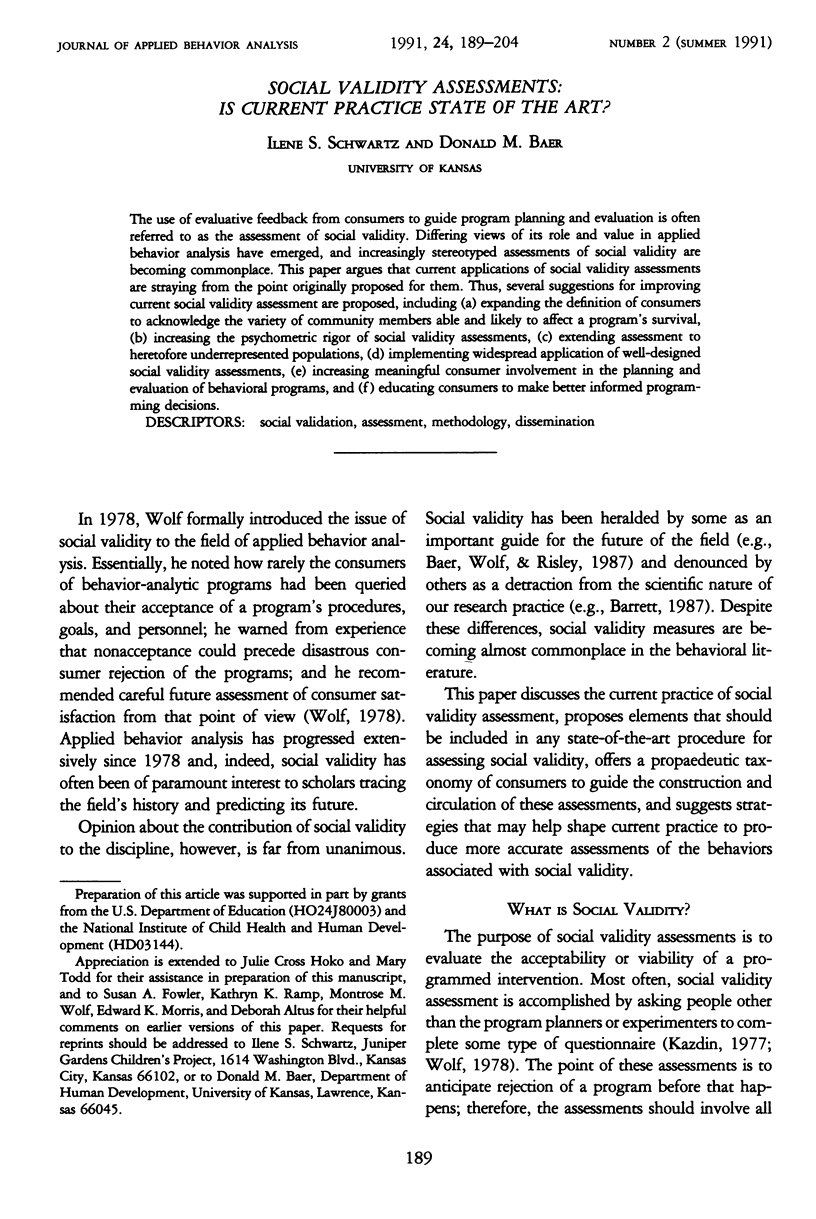
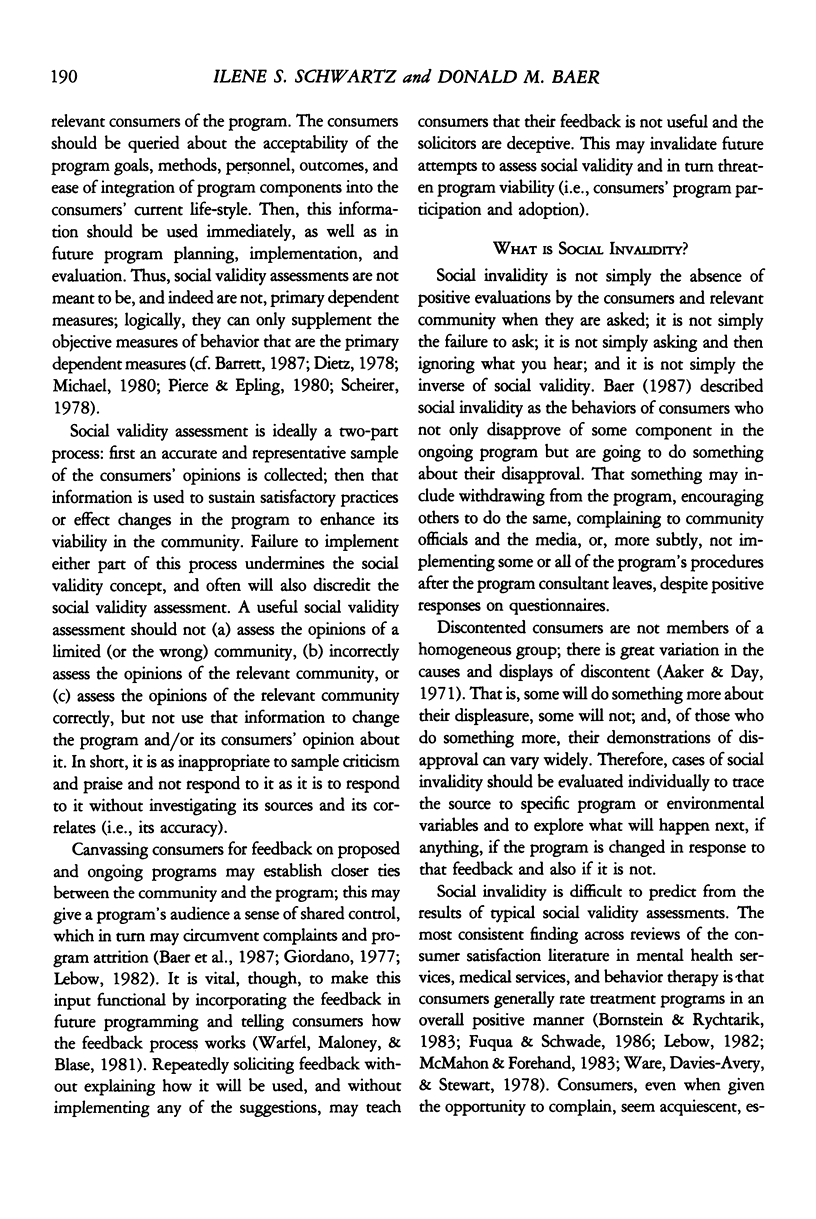




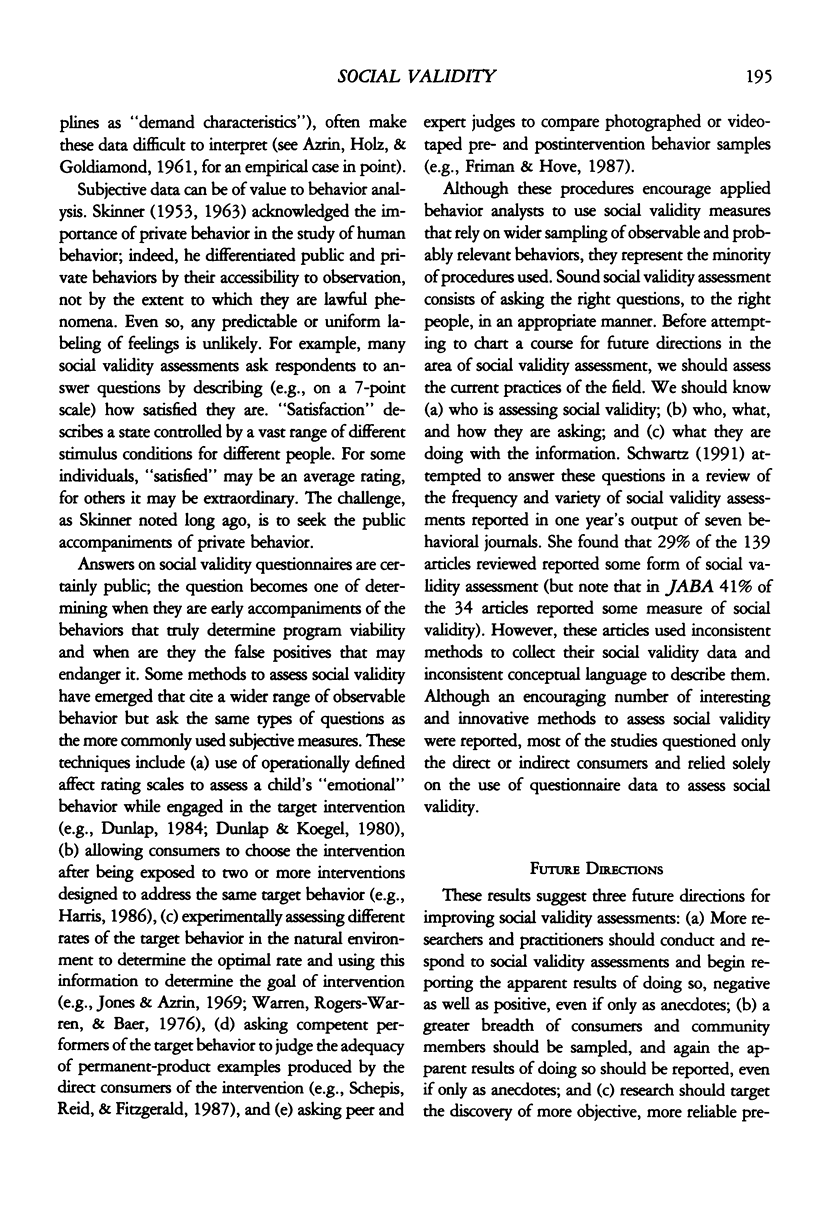

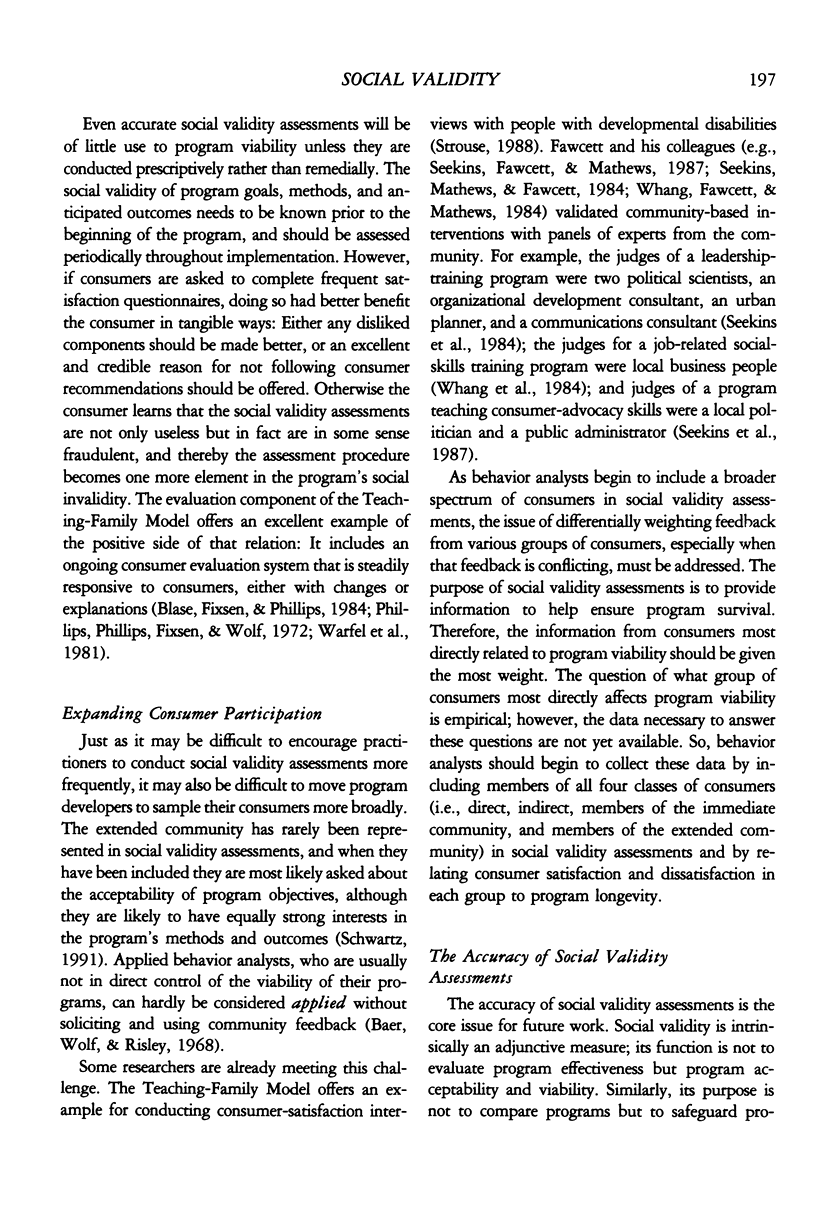
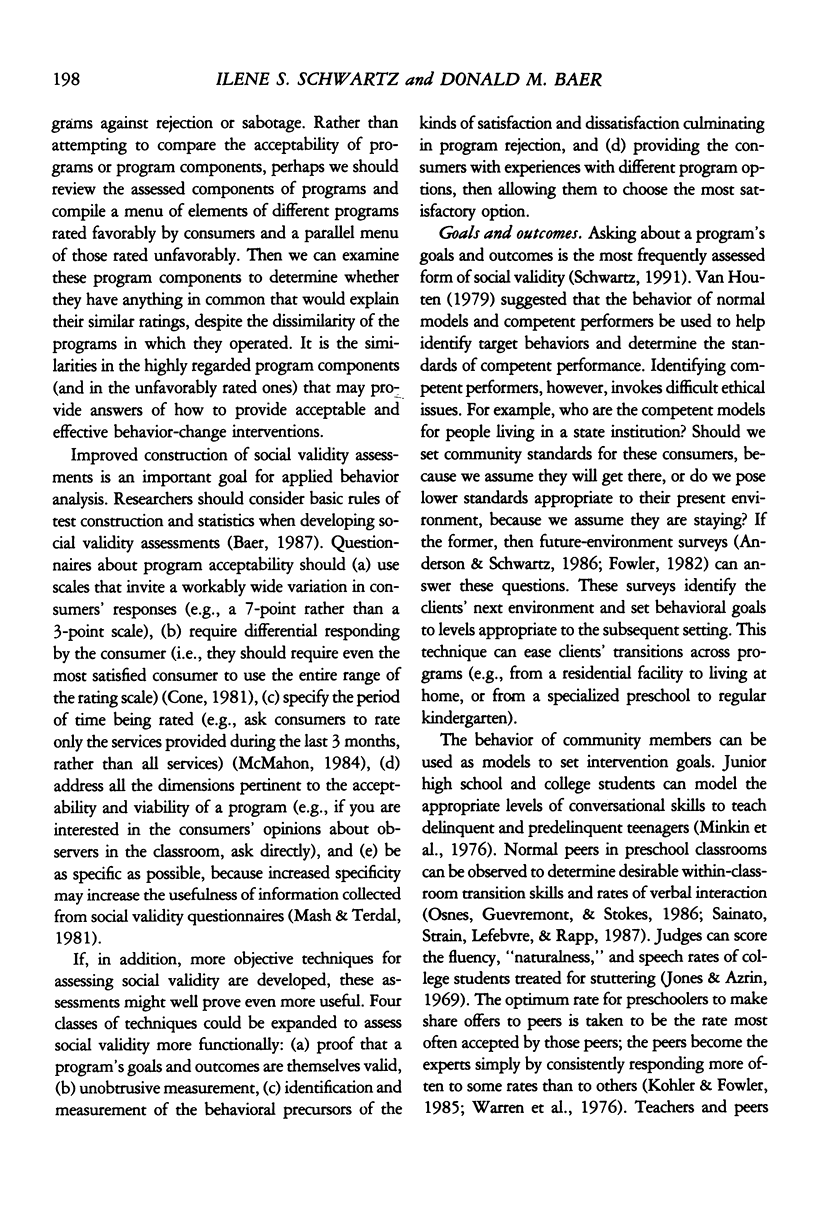

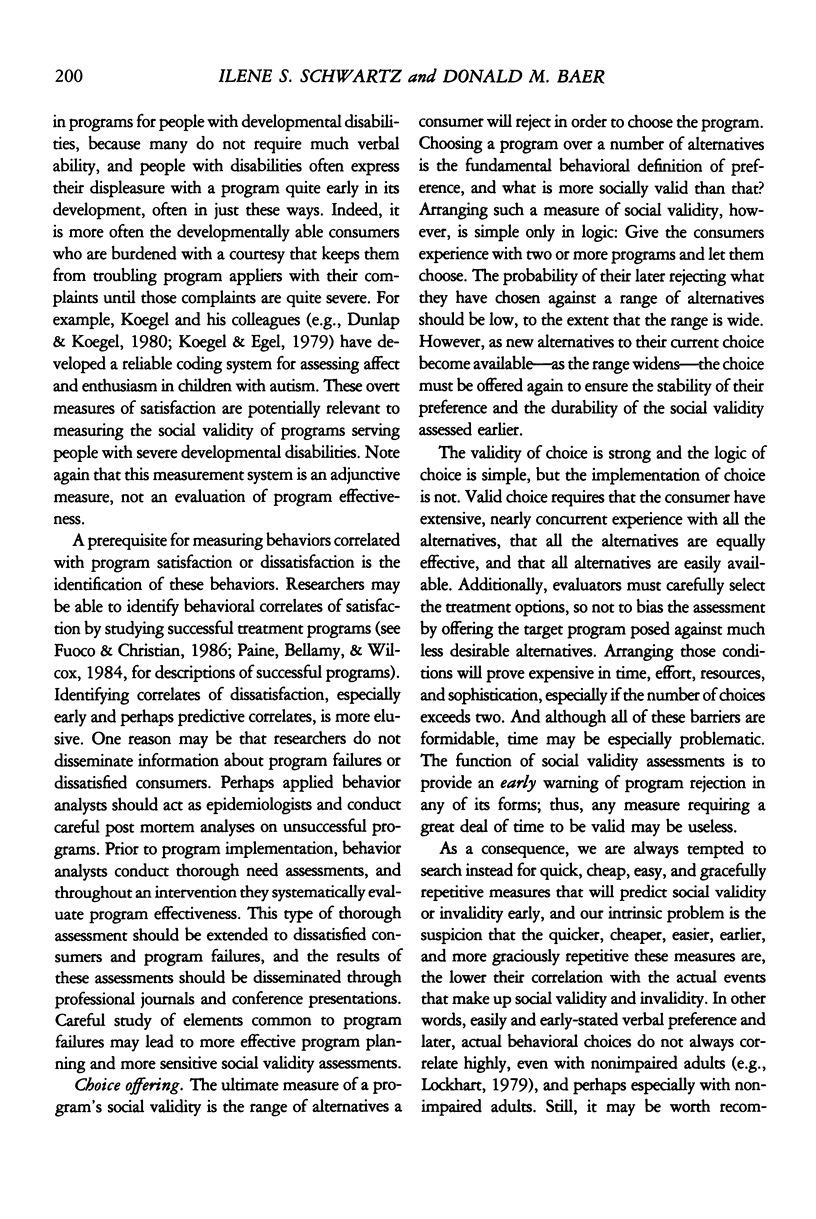


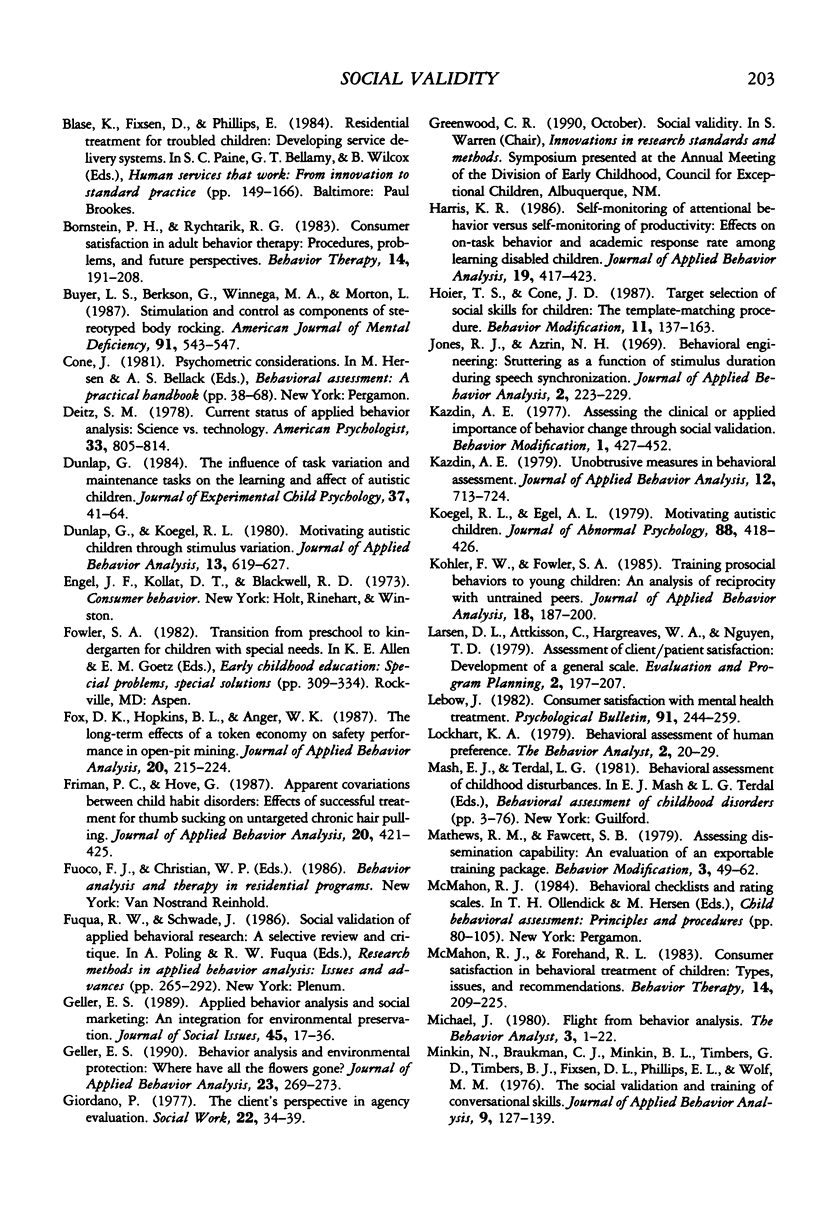
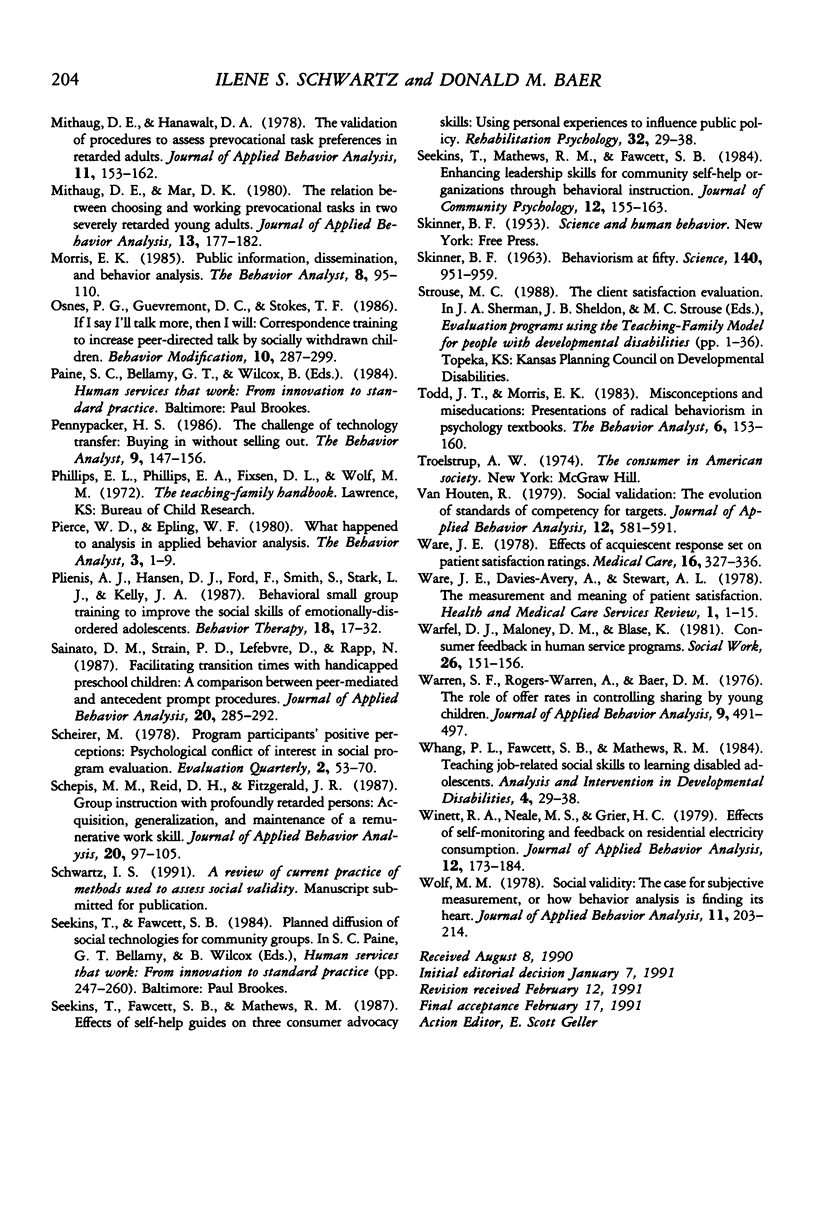
Selected References
These references are in PubMed. This may not be the complete list of references from this article.
- AZRIN N. H., HOLZ W., GOLDIAMOND I. Response bias in questionaire reports. J Consult Psychol. 1961 Aug;25:324–326. doi: 10.1037/h0044192. [DOI] [PubMed] [Google Scholar]
- Baer D. M., Wolf M. M., Risley T. R. Some current dimensions of applied behavior analysis. J Appl Behav Anal. 1968 Spring;1(1):91–97. doi: 10.1901/jaba.1968.1-91. [DOI] [PMC free article] [PubMed] [Google Scholar]
- Baer D. M., Wolf M. M. Some still-current dimensions of applied behavior analysis. J Appl Behav Anal. 1987 Winter;20(4):313–327. doi: 10.1901/jaba.1987.20-313. [DOI] [PMC free article] [PubMed] [Google Scholar]
- Buyer L. S., Berkson G., Winnega M. A., Morton L. Stimulation and control as components of stereotyped body rocking. Am J Ment Defic. 1987 Mar;91(5):543–547. [PubMed] [Google Scholar]
- Dunlap G., Koegel R. L. Motivating autistic children through stimulus variation. J Appl Behav Anal. 1980 Winter;13(4):619–627. doi: 10.1901/jaba.1980.13-619. [DOI] [PMC free article] [PubMed] [Google Scholar]
- Dunlap G. The influence of task variation and maintenance tasks on the learning and affect of autistic children. J Exp Child Psychol. 1984 Feb;37(1):41–64. doi: 10.1016/0022-0965(84)90057-2. [DOI] [PubMed] [Google Scholar]
- Fox D. K., Hopkins B. L., Anger W. K. The long-term effects of a token economy on safety performance in open-pit mining. J Appl Behav Anal. 1987 Fall;20(3):215–224. doi: 10.1901/jaba.1987.20-215. [DOI] [PMC free article] [PubMed] [Google Scholar]
- Friman P. C., Hove G. Apparent covariation between child habit disorders: effects of successful treatment for thumb sucking on untargeted chronic hair pulling. J Appl Behav Anal. 1987 Winter;20(4):421–425. doi: 10.1901/jaba.1987.20-421. [DOI] [PMC free article] [PubMed] [Google Scholar]
- Harris K. R. Self-monitoring of attentional behavior versus self-monitoring of productivity: effects on on-task behavior and academic response rate among learning disabled children. J Appl Behav Anal. 1986 Winter;19(4):417–423. doi: 10.1901/jaba.1986.19-417. [DOI] [PMC free article] [PubMed] [Google Scholar]
- Jones R. J., Azrin N. H. Behavioral engineering: stuttering as a function of stimulus duration during speech synchronization. J Appl Behav Anal. 1969 Winter;2(4):223–229. doi: 10.1901/jaba.1969.2-223. [DOI] [PMC free article] [PubMed] [Google Scholar]
- Kazdin A. E. Unobtrusive measures in behavioral assessment. J Appl Behav Anal. 1979 Winter;12(4):713–724. doi: 10.1901/jaba.1979.12-713. [DOI] [PMC free article] [PubMed] [Google Scholar]
- Koegel R. L., Egel A. L. Motivating autistic children. J Abnorm Psychol. 1979 Aug;88(4):418–426. doi: 10.1037//0021-843x.88.4.418. [DOI] [PubMed] [Google Scholar]
- Kohler F. W., Fowler S. A. Training prosocial behaviors to young children: an analysis of reciprocity with untrained peers. J Appl Behav Anal. 1985 Fall;18(3):187–200. doi: 10.1901/jaba.1985.18-187. [DOI] [PMC free article] [PubMed] [Google Scholar]
- Larsen D. L., Attkisson C. C., Hargreaves W. A., Nguyen T. D. Assessment of client/patient satisfaction: development of a general scale. Eval Program Plann. 1979;2(3):197–207. doi: 10.1016/0149-7189(79)90094-6. [DOI] [PubMed] [Google Scholar]
- Lebow J. Consumer satisfaction with mental health treatment. Psychol Bull. 1982 Mar;91(2):244–259. [PubMed] [Google Scholar]
- Minkin N., Braukmann C. J., Minkin B. L., Timbers G. D., Timbers B. J., Fixsen D. L., Phillips E. L., Wolf M. M. The social validation and training of conversational skills. J Appl Behav Anal. 1976 Summer;9(2):127–139. doi: 10.1901/jaba.1976.9-127. [DOI] [PMC free article] [PubMed] [Google Scholar]
- Mithaug D. E., Hanawalt D. A. The validation of procedures to assess prevocational task preferences in retarded adults. J Appl Behav Anal. 1978 Spring;11(1):153–162. doi: 10.1901/jaba.1978.11-153. [DOI] [PMC free article] [PubMed] [Google Scholar]
- Mithaug D. E., Mar D. K. The relation between choosing and working prevocational tasks in two severely retarded young adults. J Appl Behav Anal. 1980 Spring;13(1):177–182. doi: 10.1901/jaba.1980.13-177. [DOI] [PMC free article] [PubMed] [Google Scholar]
- Osnes P. G., Guevremont D. C., Stokes T. F. If I say I'll talk more, then I will. Correspondence training to increase peer-directed talk by socially withdrawn children. Behav Modif. 1986 Jul;10(3):287–299. doi: 10.1177/01454455860103002. [DOI] [PubMed] [Google Scholar]
- SKINNER B. F. Behaviorism at fifty. Science. 1963 May 31;140(3570):951–958. doi: 10.1126/science.140.3570.951. [DOI] [PubMed] [Google Scholar]
- Sainato D. M., Strain P. S., Lefebvre D., Rapp N. Facilitating transition times with handicapped preschool children: a comparison between peer-mediated and antecedent prompt procedures. J Appl Behav Anal. 1987 Fall;20(3):285–291. doi: 10.1901/jaba.1987.20-285. [DOI] [PMC free article] [PubMed] [Google Scholar]
- Schepis M. M., Reid D. H., Fitzgerald J. R. Group instruction with profoundly retarded persons: acquisition, generalization, and maintenance of a remunerative work skill. J Appl Behav Anal. 1987 Spring;20(1):97–105. doi: 10.1901/jaba.1987.20-97. [DOI] [PMC free article] [PubMed] [Google Scholar]
- Seekins T., Mathews R. M., Fawcett S. B. Enhancing leadership skills for community self-help organizations through behavioral instruction. J Community Psychol. 1984 Apr;12(2):155–163. doi: 10.1002/1520-6629(198404)12:2<155::aid-jcop2290120208>3.0.co;2-3. [DOI] [PubMed] [Google Scholar]
- Van Houten R. Social valdiation: the evolution of standards of competency for target behaviors. J Appl Behav Anal. 1979 Winter;12(4):581–591. doi: 10.1901/jaba.1979.12-581. [DOI] [PMC free article] [PubMed] [Google Scholar]
- Ware J. E., Jr, Davies-Avery A., Stewart A. L. The measurement and meaning of patient satisfaction. Health Med Care Serv Rev. 1978 Jan-Feb;1(1):1, 3-15. [PubMed] [Google Scholar]
- Ware J. E., Jr Effects of acquiescent response set on patient satisfaction ratings. Med Care. 1978 Apr;16(4):327–336. doi: 10.1097/00005650-197804000-00005. [DOI] [PubMed] [Google Scholar]
- Warren S. F., Rogers-Warren A., Baer D. M. The role of offer rates in controlling sharing by young children. J Appl Behav Anal. 1976 WINTER;9(4):491–497. doi: 10.1901/jaba.1976.9-491. [DOI] [PMC free article] [PubMed] [Google Scholar]
- Winett R. A., Neale M. S., Grier H. C. Effects of self-monitoring and feedback on residential electricity consumption. J Appl Behav Anal. 1979 Summer;12(2):173–184. doi: 10.1901/jaba.1979.12-173. [DOI] [PMC free article] [PubMed] [Google Scholar]
- Wolf M. M. Social validity: the case for subjective measurement or how applied behavior analysis is finding its heart. J Appl Behav Anal. 1978 Summer;11(2):203–214. doi: 10.1901/jaba.1978.11-203. [DOI] [PMC free article] [PubMed] [Google Scholar]


